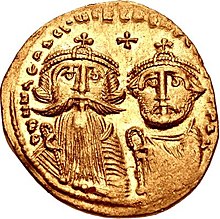Heraclius Constantine
| Heraclius Constantine | |||||||||
|---|---|---|---|---|---|---|---|---|---|
| Emperor of the Romans | |||||||||
 Solidus of Heraclius Constantine (right) with his father Heraclius (left) | |||||||||
| Byzantine emperor | |||||||||
| Reign | 11 February – 25 May 641 | ||||||||
| Coronation | 22 January 613[1] | ||||||||
| Predecessor | Heraclius | ||||||||
| Successor | Heraclonas | ||||||||
| Co-emperor | Heraclonas | ||||||||
| Born | 3 May 612[1] | ||||||||
| Died | 25 May 641[a] (aged 29) Chalcedon, Bithynia (now Kadıköy, Istanbul, Turkey) | ||||||||
| Spouse | Gregoria | ||||||||
| Issue | Constans II Theodosius | ||||||||
| |||||||||
| Dynasty | Heraclian dynasty | ||||||||
| Father | Heraclius | ||||||||
| Mother | Eudokia | ||||||||
| Religion | Chalcedonian Christianity | ||||||||
| Heraclian dynasty | ||
|---|---|---|
| Chronology | ||
|
||
|
||
|
||
|
||
|
||
|
||
| Succession | ||
|
||
Heraclius Constantine (Latin: Constantinus; Greek: Ἡράκλειος Κωνσταντῖνος, Herakleios Konstantinos; 3 May 612 – c. May 641), often enumerated as Constantine III,[b] was one of the shortest reigning Byzantine emperors, ruling for three months in 641. He was the eldest son of Emperor Heraclius and his first wife Eudokia.
Reign[]
Constantine was crowned co-emperor by his father on 22 January 613 and shortly after was betrothed to his cousin, Gregoria, a daughter of his father's first cousin, Nicetas.[6] As the couple were second cousins, the marriage was technically incestuous, but this consideration must have been outweighed by the advantages of the match to the family as a whole. Furthermore, its illegality paled into insignificance beside Heraclius' marriage to his niece Martina the same year. In comparison, Constantine's marriage was far less scandalous than that of his father.[8]
Constantine became senior Emperor when his father died on 11 February 641. He reigned together with his younger half-brother Heraclonas, the son of Martina. His supporters feared action against him on the part of Martina and Heraclonas, and the treasurer Philagrius advised him to write to the army, informing them that he was dying and asking for their assistance in protecting the rights of his children. He also sent a vast sum of money, more than two million solidi (gold coins), to Valentinus, an adjutant of Philagrius, to distribute to the soldiers to persuade them to secure the succession for his sons after his death. He died of tuberculosis after only three months, on 25 May, leaving Heraclonas sole emperor.[8] A rumor that Martina had him poisoned led first to the imposition of Constans II as co-emperor and then to the deposition, mutilation, and banishment of Martina and her sons.[6]
Family[]
In 629 or 630, Constantine married Gregoria, the daughter of Niketas.[6] They had two sons:
- Constans II, who succeeded as emperor
- Theodosius[9]
Notes[]
- ^ Or, according to the Necrologium, 20 April, which would make a total reign of 99 days (counting from 11 January) as opposed to the "103 days" (from 11 February) indicated by Nikephoros.[2] The latter date, 11 February, is traditionally the most accepted.[3]
- ^ The Byzantines themselves did not use regnal numbers, which are instead applied to the emperors by modern historians. There is particular confusion surrounding the name 'Constantine III' as it is also applied to the earlier Constantine III (r. 407–411) of the Western Roman Empire. The name has also, rarely, been used as an alternative name for Heraclius Constantine's son Constans II.[5] The Oxford Dictionary of Byzantium uses 'Herakleios Constantine' instead of 'Constantine III'[6] and uses 'Constantine III' solely for the Western emperor,[7] while the Prosopography of the Later Roman Empire uses the numeral solely for the Byzantine emperor.[4]
See also[]
References[]
Literature[]
- Bury, J.B. (1889). "Genealogical Table of the House of Heraclius". A History of the Later Roman Empire: From Arcadius to Irene. Macmillan Publishers.
- Jones, A.H.M.; J.R. Martindale & J. Morris (1971). "Constantinus 38". Prosopography of the Later Roman Empire. Vol. III. Cambridge University Press. ISBN 0-521-07233-6.
- Franzius, Enno (2021). "Heraclius". Encyclopedia Britannica.
{{cite web}}: CS1 maint: url-status (link) - Grierson, Philip (1962). "The Tombs and Obits of the Byzantine Emperors (337–1042)". Dumbarton Oaks Papers. 16. doi:10.2307/1291157. ISSN 0070-7546.
- Foss, Clive (2005). "Emperors named Constantine". Revue numismatique (in French). 6 (161): 93–102. doi:10.3406/numi.2005.2594.
- Ostrogorsky, George (1956). History of the Byzantine State. Oxford: Basil Blackwell.
- Kazhdan, Alexander, ed. (1991). "Herakleios Constantine". Oxford Dictionary of Byzantium. Oxford: Oxford University Press. ISBN 978-0-19-504652-6.
| Wikimedia Commons has media related to Konstantinos III. |
- 612 births
- 641 deaths
- 640s in the Byzantine Empire
- 7th-century Byzantine emperors
- 7th-century deaths from tuberculosis
- Heraclian Dynasty
- Heraclius
- Porphyrogennetoi
- Tuberculosis deaths in the Byzantine Empire
- Sons of Byzantine emperors